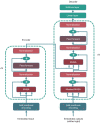Transformers in medical image segmentation: a narrative review
- PMID: 38106306
- PMCID: PMC10722011
- DOI: 10.21037/qims-23-542
Transformers in medical image segmentation: a narrative review
Abstract
Background and objective: Transformers, which have been widely recognized as state-of-the-art tools in natural language processing (NLP), have also come to be recognized for their value in computer vision tasks. With this increasing popularity, they have also been extensively researched in the more complex medical imaging domain. The associated developments have resulted in transformers being on par with sought-after convolution neural networks, particularly for medical image segmentation. Methods combining both types of networks have proven to be especially successful in capturing local and global contexts, thereby significantly boosting their performances in various segmentation problems. Motivated by this success, we have attempted to survey the consequential research focused on innovative transformer networks, specifically those designed to cater to medical image segmentation in an efficient manner.
Methods: Databases like Google Scholar, arxiv, ResearchGate, Microsoft Academic, and Semantic Scholar have been utilized to find recent developments in this field. Specifically, research in the English language from 2021 to 2023 was considered.
Key content and findings: In this survey, we look into the different types of architectures and attention mechanisms that uniquely improve performance and the structures that are in place to handle complex medical data. Through this survey, we summarize the popular and unconventional transformer-based research as seen through different key angles and analyze quantitatively the strategies that have proven more advanced.
Conclusions: We have also attempted to discern existing gaps and challenges within current research, notably highlighting the deficiency of annotated medical data for precise deep learning model training. Furthermore, potential future directions for enhancing transformers' utility in healthcare are outlined, encompassing strategies such as transfer learning and exploiting foundation models for specialized medical image segmentation.
Keywords: Transformers; artificial intelligence (AI); deep learning; image segmentation; medical imaging.
2023 Quantitative Imaging in Medicine and Surgery. All rights reserved.
Conflict of interest statement
Conflicts of Interest: All authors have completed the ICMJE uniform disclosure form (available at https://qims.amegroups.com/article/view/10.21037/qims-23-542/coif). The authors have no conflict of interest to share.
Figures





References
-
- Norouzi A, Rahim MS, Altameem A, Saba T, Rad AE, Rehman A, Uddin M. Medical image segmentation methods, algorithms, and applications. IETE Tech Rev 2014;31:199-213. 10.1080/02564602.2014.906861 - DOI
-
- Kayalibay B, Jensen G, van der Smagt P. CNN-based segmentation of medical imaging data. arXiv:1701.03056 [Preprint]. 2017. Available online: https://arxiv.org/abs/1701.03056
-
- Vaswani A, Shazeer N, Parmar N, Uszkoreit J, Jones L, Gomez AN, Kaiser Ł, Polosukhin I. Attention is all you need. In: Advances in Neural Information Processing Systems 30 (NIPS 2017). 2017.
Publication types
LinkOut - more resources
Full Text Sources
